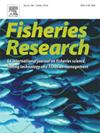IF 2.2
2区 农林科学
Q2 FISHERIES
引用次数: 0
摘要
包括鲨鱼、鳐鱼和魟在内的鳞鳃亚纲动物通常繁殖率较低,因此其种群数量很容易因死亡率升高而下降。虽然鳐鱼偶尔会成为商业捕捞的目标,但它们通常是底栖渔业的附带渔获物。释放捕获的活体个体通常被用作防止鳐鱼数量下降的管理措施。捕获后,有必要对鳐鱼的身体状况进行目测评估,以避免丢弃死亡或严重受伤的个体。还需要良好的处理方法,以提高释放后的存活率。我们的研究调查了在南印度洋作业的巴塔哥尼亚齿鱼延绳钓渔业的鳐鱼处理方法和身体状况评估方法。我们对 171 条延绳钓捕获的鳐鱼进行了拍照,并由受过箭形目动物健康培训的专业兽医对图像进行分析,以确定损伤的特征,并定性预测每种损伤类型对鳐鱼放流后存活率的物理和生理影响。我们发现了 13 种受伤类型,其中 10 种是捕获过程造成的。在这些损伤中,有两种被认为是不可逆转的,因此建议始终保留个体。所检查的大多数损伤从浅表到严重不等,尤其是口腔/下颌损伤。根据这些结果,我们以海报和综合视频教程的形式制定了最佳操作指南和状况评估。它们为管理者和延绳钓渔船船员提供了明确的指导,以处理 1) 应保留或在海上活体放生的个体的状况,以及 2) 在放生前尽量减少进一步伤害的处理方法。这里制定的处理方法和状况评估指南也很容易调整用于管理其他延绳钓渔业的鳐鱼兼捕渔获物。本文章由计算机程序翻译,如有差异,请以英文原文为准。
Condition assessment and best-practice handling guidelines for skate (Rajiformes) bycatch: Lessons from demersal longline fisheries in the Southern Indian Ocean
Elasmobranchs, including sharks, skates and rays, are often characterised by low reproductive rates, rendering their populations susceptible to declines in abundance caused by elevated mortality rates. While skates are occasionally targeted by commercial fisheries, they are commonly caught as incidental bycatch in demersal fisheries. The release of captured individuals that are still alive is often used as a management measure to prevent declines in skate populations. Upon capture, a visual assessment of skate physical condition is necessary to avoid discarding of dead or badly injured individuals. Good handling practices are also required to promote post-release survival. Our study investigated skate handling practices and the condition assessment method of Patagonian toothfish longline fisheries operating in the Southern Indian Ocean. A total of 171 longline captured skates were photographed, and the images analysed by specialist veterinarians trained in elasmobranch health to characterise injuries and qualitatively predict the physical and physiological consequences of each injury type on skate post-release survival. We found 13 types of injury, 10 of which were attributed to the capture process. Among these injuries, two were deemed irreversible, prompting a recommendation to retain the individual at all times. The majority of the examined injuries ranged from superficial to severe, particularly in cases of mouth/jaw damage. Based on these results, we developed best-practice handling guidelines and condition assessments, in form of posters and a comprehensive video tutorial. They provide clear guidance for managers and longline fishing crew for addressing 1) the condition of individuals that should be retained or released at sea alive and 2) handling practices to minimise further injury prior to the release. The guidelines for handling practices and condition assessments developed here can also be easily adapted to manage skate bycatch in other longline fisheries.
求助全文
通过发布文献求助,成功后即可免费获取论文全文。
去求助
来源期刊

Fisheries Research
农林科学-渔业
CiteScore
4.50
自引率
16.70%
发文量
294
审稿时长
15 weeks
期刊介绍:
This journal provides an international forum for the publication of papers in the areas of fisheries science, fishing technology, fisheries management and relevant socio-economics. The scope covers fisheries in salt, brackish and freshwater systems, and all aspects of associated ecology, environmental aspects of fisheries, and economics. Both theoretical and practical papers are acceptable, including laboratory and field experimental studies relevant to fisheries. Papers on the conservation of exploitable living resources are welcome. Review and Viewpoint articles are also published. As the specified areas inevitably impinge on and interrelate with each other, the approach of the journal is multidisciplinary, and authors are encouraged to emphasise the relevance of their own work to that of other disciplines. The journal is intended for fisheries scientists, biological oceanographers, gear technologists, economists, managers, administrators, policy makers and legislators.
 求助内容:
求助内容: 应助结果提醒方式:
应助结果提醒方式:


